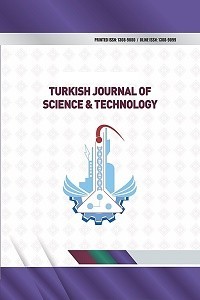Classification of Skin Cancer Images with Convolutional Neural Network Architectures
Classification of Skin Cancer Images with Convolutional Neural Network Architectures
CNN, Classification, Deep Learning Image Processing, Skin Cancer,
___
- [1] Kabashima, K., Honda, T., Ginhoux, F., & Egawa, G. (2019). The immunological anatomy of the skin. Nature Reviews Immunology, 19(1), 19-30. https://doi.org/10.1038/s41577-018-0084-5
- [2] American Cancer Society: Cancer facts and figures, Aug 2018, [online] Available: https://www.cancer.org/content/dam/cancer-org/research/cancer-factsand-statistics/annual-cancer-facts-and-figures/2018/cancer-facts-andfigures-2018.pdf.
- [3] N. C. F. Codella et al., "Deep learning ensembles for melanoma recognition in dermoscopy images", IBM Journal of Research and Development, vol. 61, pp. 5:1-5:15, 2017.
- [4] Taroni, P., Paganoni, A. M., Ieva, F., Pifferi, A., Quarto, G., Abbate, F., ... & Cubeddu, R. (2017). Non-invasive optical estimate of tissue composition to differentiate malignant from benign breast lesions: A pilot study. Scientific reports, 7(1), 1-11. https://doi.org/10.1038/srep40683.
- [5] Wylie, J. D., Jenkins, P. A., Beckmann, J. T., Peters, C. L., Aoki, S. K., & Maak, T. G. (2018). Computed tomography scans in patients with young adult hip pain carry a lifetime risk of malignancy. Arthroscopy: The Journal of Arthroscopic & Related Surgery, 34(1), 155-163. https://doi.org/10.1016/j.arthro.2017.08.235
- [6] Yap, J., Yolland, W., & Tschandl, P. (2018). Multimodal skin lesion classification using deep learning. Experimental dermatology, 27(11), 1261-1267.https://doi.org/10.1111/exd.13777
- [7] Bottou, L. (2010). Large-scale machine learning with stochastic gradient descent. In Proceedings of COMPSTAT'2010(pp. 177-186). Physica-Verlag HD.
- [8] Deng, L.,& Yu, D. (2014). Deep learning: methods and applications. Foundations and Trends® in Signal Processing, 7(3–4), 197- 387.
- [9] Espinosa, J. E., Velastin, S. A., & Branch, J. W. (2017, November). Vehicle detection using alex net and faster R-CNN deep learning models: a comparative study. In International Visual Informatics Conference (pp. 3-15). Springer, Cham. https://doi.org/10.1007/978-3-319-70010-6_1
- [10] Singh, A. K., Ganapathysubramanian, B., Sarkar, S., & Singh, A. (2018). Deep learning for plant stress phenotyping: trends and future perspectives. Trends in plant science, 23(10), 883-898. https://doi.org/10.1016/j.tplants.2018.07.004
- [11] Yildirim, M., Cinar, A. (2020). A deep learning based hybrid approach for COVID-19 disease detections. Traitement du Signal, 37(3): 461-468. https://doi.org/10.18280/ts.370313.
- [12] Huang, G., Liu, Z., Van Der Maaten, L., & Weinberger, K. Q. (2017). Densely connected convolutional networks. In Proceedings of the IEEE conference on computer vision and pattern recognition (pp. 4700-4708).
- [13] Krizhevsky, A., Sutskever, I., & Hinton, G. E. (2012). Imagenet classification with deep convolutional neural networks. In Advances in neural information processing systems (pp. 1097-1105).
- [14] Szegedy, C., Liu, W., Jia, Y., Sermanet, P., Reed, S., Anguelov, D., ... & Rabinovich, A. (2015). Going deeper with convolutions. In Proceedings of the IEEE conference on computer vision and pattern recognition (pp. 1-9).
- [15] He, K., Zhang, X., Ren, S., & Sun, J. (2016). Deep residual learning for image recognition. In Proceedings of the IEEE conference on computer vision and pattern recognition (pp. 770-778).
- [16] https://www.kaggle.com/naim99/segmented-images-of-the-skin-cancer-dataset
- [17] Yildirim, M., Çinar, A. (2019). Classification of white blood cells by deep learning methods for diagnosing disease. Revue d'Intelligence Artificielle, Vol. 33, No. 5, pp. 335-340. https://doi.org/10.18280/ria.330502
- [18] Liu, Z. (2020). Soft-shell shrimp recognition based on an improved AlexNet for quality evaluations. Journal of Food Engineering, 266, 109698. https://doi.org/10.1016/j.jfoodeng.2019.109698
- [19] Zahisham, Z., Lee, C. P., & Lim, K. M. (2020, September). Food Recognition with ResNet-50. In 2020 IEEE 2nd International Conference on Artificial Intelligence in Engineering and Technology (IICAIET) (pp. 1-5). IEEE. doi: 10.1109/IICAIET49801.2020.9257825.
- [20] Carcagnì, P., Leo, M., Cuna, A., Mazzeo, P. L., Spagnolo, P., Celeste, G., & Distante, C. (2019, September). Classification of skin lesions by combining multilevel learnings in a DenseNet architecture. In International Conference on Image Analysis and Processing (pp. 335-344). Springer, Cham. https://doi.org/10.1007/978-3-030-30642-7_30
- [21] Al-Qizwini, M., Barjasteh, I., Al-Qassab, H., & Radha, H. (2017, June). Deep learning algorithm for autonomous driving using googlenet. In 2017 IEEE Intelligent Vehicles Symposium (IV) (pp. 89-96). IEEE. doi: 10.1109/IVS.2017.7995703.
- [22] Çinar, A., Yıldırım, M. (2020). Detection of tumors on brain MRI images using the hybrid convolutional neural network architecture. Medical Hypotheses, 139: 109684. https://doi.org/10.1016/j.mehy.2020.109684
- [23] Yildirim, M., Cinar, A. (2020). Classification of Alzheimer's disease MRI images with CNN based hybrid method. Ingénierie des Systèmes d’Information, Vol. 25, No. 4, pp. 413-418. https://doi.org/10.18280/isi.250402
- ISSN: 1308-9080
- Başlangıç: 2009
- Yayıncı: Fırat Üniversitesi
Ahmet COBAN, Gökçe KENDİRLİOĞLU ŞİMŞEK, Prof. Dr. A. Kadri ÇETİN
On Generalized Mannheim curves İn The Equform Geometry Of the Galilean 4-Space
Mutasyona Uğramış RNA tipli Göğüs Kanseri Verilerinin Makine Öğrenme Yöntemleri ile Analizi
Classification of Skin Cancer Images with Convolutional Neural Network Architectures
Muhammed YILDIRIM, Ahmet ÇINAR
The Characterızatıons Of Null Quaternionic Curves In Minkowski 3-Space
Şeyda ÖZEL, Mihriban ALYAMAC KULAHCİ, Mehmet BEKTAŞ
Against Digital Extinction: Cyber Peace
Special Curves According to Extended Darboux Frame Field in ?? ?
Esra ERDEM, Mihriban ALYAMAC KULAHCİ, Münevver Yıldırım YILMAZ
Gürkan GÜRGÖZE, İbrahim TÜRKOĞLU
Investigation of Electrophoretic Mobility of Various Nanofibers in Ethanol or Water
